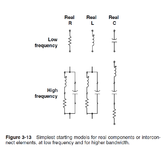engr_joni_ee
Advanced Member level 3
Hi,
The impedance of a capacitor decrease with frequency.
The impedance of a inductor increase with frequency.
How the capacitance and inductance changes with frequency ?
At which frequency when designing PCB layout the SMD packages of R L and C have significant changes ?
The impedance of a capacitor decrease with frequency.
The impedance of a inductor increase with frequency.
How the capacitance and inductance changes with frequency ?
At which frequency when designing PCB layout the SMD packages of R L and C have significant changes ?
